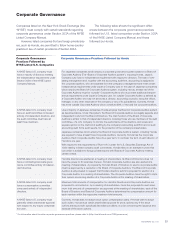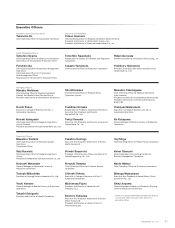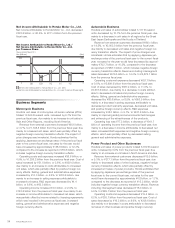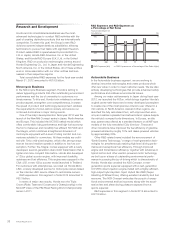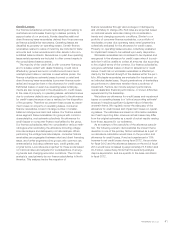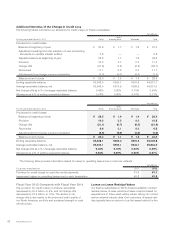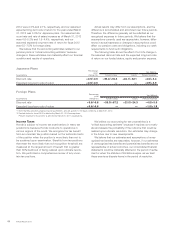Honda 2012 Annual Report Download - page 39
Download and view the complete annual report
Please find page 39 of the 2012 Honda annual report below. You can navigate through the pages in the report by either clicking on the pages listed below, or by using the keyword search tool below to find specific information within the annual report.
Power Product and Other Businesses
In the Power product and other businesses segments, Honda
introduced several measures in accordance with its business
policy of proactively proposing new and useful ideas that will
bring joy to customers worldwide. These centered on the
creation of new technology for advanced industrial markets,
the development of strategic products for emerging markets,
the establishment of a foundation for addressing growth in
overseas production and efforts to strengthen the develop-
ment operations supporting business operations.
Principal developments in this area included the sales
launch to gas utility companies of a new model gas engine-
based cogeneration unit for household use. This high-efficiency,
household-use combined heat and power supply system, the
MCHP1.0K2, generates power using a gas-powered engine,
utilizing the subsequent waste heat to supply hot water. The
MCHP1.0K2 incorporates EXLink (Extended Expansion
Linkage Engine), an original Honda product that boosts the
efficiency of both power generation and heat utilization. As
the world’s smallest gas engine-based cogeneration unit, the
MCHP1.0K2 can now be installed in more ordinary house-
holds than ever before. In the area of outboard motors, we
released the BF250, featuring top-of-class fuel efficiency and
superior output performance, in Japan, North America,
Europe, Southeast Asia and other regions. The BF250 has a
newly developed 3.6 L V-6 VTEC engine, combined with a
direct air intake system, the first ever application of this tech-
nology to an outboard motor. In the general-purpose engine
category, Honda further reduced noise and vibration levels in
a number of engines in the GX engine series. Sold in Japan,
these engines also boast top-of-class low exhaust gas
emissions and high fuel economy.
R&D expenses in this segment in fiscal 2012 amounted to
¥28.6 billion.
Fundamental Research
During fiscal 2012, Honda continued its fundamental research
activities to develop technologies in a diverse range of fields
that will support the products of the future.
The major initiative undertaken during the fiscal year was
the evolution of the ASIMO humanoid robot. Equipping
ASIMO for the first time ever with autonomous behavior con-
trol technology has made it more independent, enabling the
robot to move continuously without navigation input from a
human operator. In terms of intelligence and physical form,
the ability of ASIMO to adapt to conditions has improved
dramatically, bringing it one step closer to practical usage in
environments of coexistence with humans. Development is
also proceeding on a task-performing robot arm. For this
device, Honda is applying the posture control technology that
allows ASIMO to walk and run, along with multi-joint simulta-
neous trajectory control technology, which controls the
motors in ASIMO’s hand and foot joints all at once, to enable
tasks to be performed in locations too dangerous for humans
or where footing is unstable.
Honda is committed to continuing its humanoid robotics
research, and will take proactive steps to convert this research
into products for mass production and practical or applied use.
Please note that expenses incurred in fundamental
research are allocated among each business segment.
Patents and Licenses
At March 31, 2012, Honda owned more than 17,600 patents
in Japan and more than 25,300 patents abroad. Honda also
had applications pending for more than 13,200 patents in
Japan and for more than 16,200 patents abroad. While
Honda considers that, in the aggregate, Honda’s patents are
important, it does not consider any one of such patents, or
any related group of them, to be of such importance that the
expiration or termination thereof would materially affect
Honda’s business.
Capital Expenditures
Capital expenditures in fiscal 2012 were applied to the introduction of new models, as well as the improvement, streamlining and
modernization of production facilities, and improvement of sales and R&D facilities.
Total capital expenditures for the year amounted to ¥1,090.3 billion, decreased ¥19.4 billion from the previous year. Also, total
capital expenditures, excluding property on operating leases, for the year amounted to ¥406.5 billion, increased ¥95.2 billion from
the previous year. Spending by business segment is shown below.
Yen (millions)
Fiscal years ended March 31 2011 2012
Increase
(Decrease)
Motorcycle Business ¥ 37,084 ¥ 62,075 ¥ 24,991
Automobile Business 260,149 334,196 74,047
Financial Services Business 798,584 684,083 (114,501)
Financial Services Business (Excluding Property on Operating Leases) 164 316 152
Power Product and Other Businesses 13,963 10,005 (3,958)
Total ¥1,109,780 ¥1,090,359 ¥ (19,421)
Total (Excluding Property on Operating Leases) ¥ 311,360 ¥ 406,592 ¥ 95,232
Note: Intangible assets are not included in the table above.
Honda Motor Co., Ltd. 37




